Crystal Blue Resort, Anilao, PhilippinesContents of this Issue: Crystal Blue Resort, Anilao, Philippines What You Need to Know About The Philippines A New Tip on Avoiding a Cold that Could Ruin Your Dive Trip Hey, Divers, Don’t Eat the Reef Fish Roatan, the Brac, Sulawesi, Fiji … Others Want To Read About Your Trips California’s Giant Sea Bass — Friend or Food? Is That Warranty Worth the Paper It’s Written On? Double Depth-Record Bids End in Tragedies Will Your Liveaboard’s Insurance Cover Your Loss? Deadly Air Kills Experienced Diver Are Today’s Regulators Better than of Old? Who Fact Checks “Oxygen-Breathing Diver”? New Critters to Spot Along the West Coast Looking for a Holiday Gift? Here Are Three Great Books Editorial Office: Ben Davison Publisher and Editor Undercurrent 3020 Bridgeway, Suite 102 Sausalito, CA 94965 making much of the muck from the November, 2017 issue of Undercurrent
Dear Fellow Diver: The only way to enter the water from a Filipino bangka is by backward roll, and when I hit the 78-degree (25°C) water in April, I was glad to be wearing my 5mm wetsuit. As a Caribbean diver for the past 30 years, it wasn't only the cool water that got my attention; the visibility was a mere 25-30 feet (8-10m), and on many dives, there were no colorful corals or sponges. Instead, there was the much-advertised muck, which is gray sand and gravel that the local photo pros call "substrate." For this, I flew 11 hours from San Francisco to Tokyo and another 7 hours to Manila?
CBR limited a bangka to four divers and one guide, and my guide was both professional and serious about doing a good job. He was about 35 years old and married with a child, and in the impoverished Philippine economy, a dive guide is fairly well paid. If I asked for a specific critter, he would look for it, pointing it out with either a flashlight or a pointer. I had the same guide for a week -- I'm told most other Anilao resorts switch guides daily -- so we got to know each other well, which enhanced our communication both above and below the surface. I traveled with 20 Americans hooked on underwater photography. Nominally we dived in buddy teams, but in reality, we four divers and our guide decided upon a subject (e.g., frogfish, nudis, clown fish, pygmy seahorse, etc.), and the guide would choose a site and nearly always find what we sought. Because the critters are small, only one diver at a time can shoot, and the guide worked one-on-one with that diver to help get the shot. Obviously, we had to wait our turns, so while keeping the guide in sight, I looked for other things to shoot, not venturing beyond the range of visibility. This is diving for experienced divers who are comfortable taking care of themselves. I also enjoyed some reef and wreck diving. Sombrero, a small, uninhabited island, had enough soft coral to entice wide-angle photographers, and the visibility was better, maybe 40-50 feet (12- 15m). As for wreck diving, the most popular is a former floating casino, the Daryl Laut, that sank in the late 1970s. Legend has it that the owners torched it for the insurance proceeds. The top of the encrusted 80-foot wreck sits at about 40 feet (12m), and it extends down to about 90 feet (27m). The outer structure was salvaged, but nearly the entire frame remains, making for good wide-angle shots with a blue background; the life included flatworms, scorpion fish, and nudis.
Besides having flat bottoms, the wooden bangkas -- 18-25 feet (5-7m) long with a six- to seven-foot beam -- are powered by old truck engines and have bamboo outriggers on both sides. To move around, I had to crouch down beneath the low-slung canvas midsection. We divers sat on the gunwales from which we did our backroll. If there was any chop, we got wet in transit. The boatmen set up our gear, and not only brought it to us, but also helped us don it while remaining seated. The portable wooden ladders hooked over the gunwales, and, after handing up weights and tanks/BCDs, it took a climb up several steps with no handholds other than the ladder steps and a half-crawl over the gunwale to get onboard.
There is no dock, so the bangka is beached, and the boatmen and divers must get on and off by walking a wobbly, wooden 6-inch-wide plank. While most divers need assistance, the boatmen dashed back and forth carrying the tanks and BCDs on their shoulders. While it's not a problem to fall into the shallow water wearing a wetsuit -- I did twice -- one can certainly do without the guffaws and ribbing from fellow divers. It's a rocky beach, so you need either booties or sandals. Almost every morning on the beach were several locals -- some with small children -- offering to sell us cheap beads. It was a sad thing to see, and an unfortunate fact of life in such a poverty-stricken country; despite how truly needy they were, we were in our wetsuits with no cash. Some people returned to help out.
I didn't know that the Philippines are geologically active, and I felt several small earthquakes, one strong enough to topple a shampoo bottle in the bathroom. Indeed, toward the end of the trip, we did not even comment upon the tremors. Due to the quakes and other causes, the electricity went off briefly from time to time, but never long enough to dissipate the air conditioning in my room. In light of several recent news reports about the terrorist-related conflict in the Philippines -- it's on Mindanao, an island 500 miles south of Manila -- I must report that I never felt the slightest bit unsafe. CBR has an armed guard at night, as do other resorts in the area.
CBR offers no land excursions, so with no nearby bars, restaurants or nightlife, during my 10 days at CBR, no one left the resort. CBR has a small bar; drinks are about $5, and wine is sold only by the bottle from their tiny selection. So, CBR is a great place for a diver wishing to shoot the small, even miniature critters of the reef, but divers with other goals (and those accompanied by nondivers) may be disappointed. After I had a chance to review all my shots -- the number and diversity of nudis were incredible --I'm indeed glad I made the long journey. The accommodations, food and extremely helpful and knowledgeable guides made for a unique and rewarding experience. -- GPT Our undercover diver's bio: GPT was certified in 1983 and has made more than 900 dives throughout the Caribbean, California, Australia, and Hawaii. For the past 10 years, he's taken several organized underwater photography trips where instruction is an important feature.
|

I want to get all the stories! Tell me how I can become an Undercurrent Online Member and get online access to all the articles of Undercurrent as well as thousands of first hand reports on dive operations world-wide
| Home | Online Members Area | My Account |
Login
|
Join
|
| Travel Index |
Dive Resort & Liveaboard Reviews
|
Featured Reports
|
Recent
Issues
|
Back Issues
|
|
Dive Gear
Index
|
Health/Safety Index
|
Environment & Misc.
Index
|
Seasonal Planner
|
Blogs
|
Free Articles
|
Book Picks
|
News
|
|
Special Offers
|
RSS
|
FAQ
|
About Us
|
Contact Us
|
Links
|
3020 Bridgeway, Ste 102, Sausalito, Ca 94965
All rights reserved.

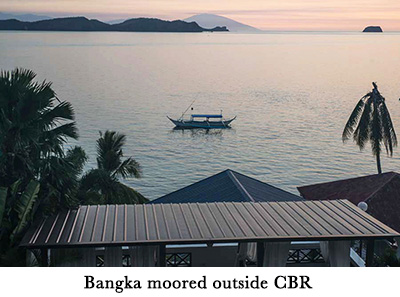 But, the Filipino dive guides made it all worthwhile as they consistently showed me unique, colorful and exciting critters that were fantastic for macro photography: hairy frogfish; mantis shrimp; colmani shrimp in pairs atop fire urchins; blue ring octopus; ribbon eels and nudibranchs. (In fact, some call it the nudibranch capital of the world!) And the guides know right where to find a half-inch pygmy seahorse camouflaged in a same-colored sea fan. I enjoyed the challenge of working patiently to get pictures of several species of "Nemo" for my nondiving friends. As opposed to the Caribbean, most of the frogfish had not disappeared into sponges of an identical
color, so I could easily spot and
shoot them. And I had the time, since
a typical dive ran about 70 minutes
because the depth was typically less
than 60 feet (18m) and often as
little as 25 feet (8m). They recommended
gloves, and with beer cans and
broken glass in the muck, I'm glad I
brought mine (especially because they
did not sell gloves).
But, the Filipino dive guides made it all worthwhile as they consistently showed me unique, colorful and exciting critters that were fantastic for macro photography: hairy frogfish; mantis shrimp; colmani shrimp in pairs atop fire urchins; blue ring octopus; ribbon eels and nudibranchs. (In fact, some call it the nudibranch capital of the world!) And the guides know right where to find a half-inch pygmy seahorse camouflaged in a same-colored sea fan. I enjoyed the challenge of working patiently to get pictures of several species of "Nemo" for my nondiving friends. As opposed to the Caribbean, most of the frogfish had not disappeared into sponges of an identical
color, so I could easily spot and
shoot them. And I had the time, since
a typical dive ran about 70 minutes
because the depth was typically less
than 60 feet (18m) and often as
little as 25 feet (8m). They recommended
gloves, and with beer cans and
broken glass in the muck, I'm glad I
brought mine (especially because they
did not sell gloves).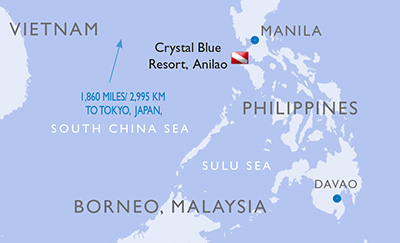 For some divers, the day began in the outdoor dining room at 5:30 A.M. when
the WIFI was strongest, but mostly there was no WIFI (which meant I did not constantly
see people with their faces in their Smartphones). My day typically began
at 6:30 A.M. with breakfast overlooking the water, seated at long tables that
accommodated 10 or more. All meals were buffet-style, and for breakfast, besides
eggs or omelets, they offered fruit, cereal, oatmeal, and bacon or sausage, as
well as toast and rolls. Coffee was available 24/7, and the helpful wait staff
kept my water glasses full. (Tap water is not potable, so CBR provided bottles,
which I refilled from dispensers around the resort.) For the first two days, I ate fresh salads at both lunch and dinner, which tasted fine, but I think they gave me a touch of Montezuma's. After speaking to an American dive leader who won't touch salads in the Philippines, I stopped eating salad, and my discomfort subsided quickly, and I only lost one morning dive. Buffet lunch and dinners included several tasty entrees -- beef, pork, chicken, and seafood, prepared mostly American-style with local spices -- as well as fresh vegetables, potatoes, pasta, and dessert.
For some divers, the day began in the outdoor dining room at 5:30 A.M. when
the WIFI was strongest, but mostly there was no WIFI (which meant I did not constantly
see people with their faces in their Smartphones). My day typically began
at 6:30 A.M. with breakfast overlooking the water, seated at long tables that
accommodated 10 or more. All meals were buffet-style, and for breakfast, besides
eggs or omelets, they offered fruit, cereal, oatmeal, and bacon or sausage, as
well as toast and rolls. Coffee was available 24/7, and the helpful wait staff
kept my water glasses full. (Tap water is not potable, so CBR provided bottles,
which I refilled from dispensers around the resort.) For the first two days, I ate fresh salads at both lunch and dinner, which tasted fine, but I think they gave me a touch of Montezuma's. After speaking to an American dive leader who won't touch salads in the Philippines, I stopped eating salad, and my discomfort subsided quickly, and I only lost one morning dive. Buffet lunch and dinners included several tasty entrees -- beef, pork, chicken, and seafood, prepared mostly American-style with local spices -- as well as fresh vegetables, potatoes, pasta, and dessert.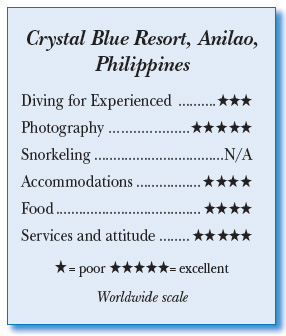 The bangkas left at 8:30 A.M. for the two-tank morning dive, typically a 20- to 45-minute ride. For our one-hour surface interval, the boatman usually pulled up to a rocky beach, where we hydrated with water, hot coffee or chocolate, and munched cookies. Some folks waded ashore, but a 5-mil is not the best strolling attire in the blaring tropical sun. Nor was there much to see, other than the modest homes, often only shacks. After the second dive, it was back to the resort for lunch, maybe a nap, then a 3 P.M. dive. Also, there was a 5 P.M. boat dive right off the resort. If four divers with boundless energy could be found, they offered a night boat dive on a sandy bottom at 10-12 feet (3m).
The bangkas left at 8:30 A.M. for the two-tank morning dive, typically a 20- to 45-minute ride. For our one-hour surface interval, the boatman usually pulled up to a rocky beach, where we hydrated with water, hot coffee or chocolate, and munched cookies. Some folks waded ashore, but a 5-mil is not the best strolling attire in the blaring tropical sun. Nor was there much to see, other than the modest homes, often only shacks. After the second dive, it was back to the resort for lunch, maybe a nap, then a 3 P.M. dive. Also, there was a 5 P.M. boat dive right off the resort. If four divers with boundless energy could be found, they offered a night boat dive on a sandy bottom at 10-12 feet (3m).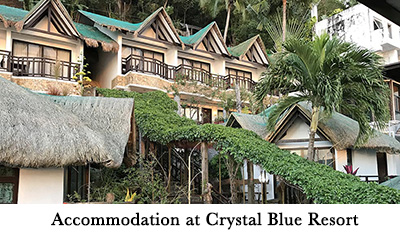 There are two boatmen for each bangka, and pound for pound, they are powerful fellows. They carried all gear on and off the boat daily, rinsed it nightly, and hung it up to dry. In the midst of a simple chat between dives, one straightforwardly asked me, "How old are you?" According to an American who lives there, it's a Filipino thing, and they mean no offense, but be prepared to have your age-fib already in mind.
There are two boatmen for each bangka, and pound for pound, they are powerful fellows. They carried all gear on and off the boat daily, rinsed it nightly, and hung it up to dry. In the midst of a simple chat between dives, one straightforwardly asked me, "How old are you?" According to an American who lives there, it's a Filipino thing, and they mean no offense, but be prepared to have your age-fib already in mind.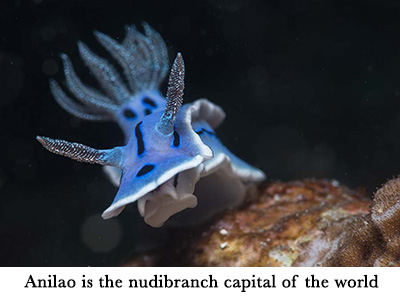 My room, with a balcony and lovely view, had a comfortable bed, a small desk, and air conditioning, and would have been tight for two. Maids cleaned daily, and overall, the staff tried hard to fulfill every request. Like all Anilao resorts, CBR is built on a steep mountainside. This setting is picturesque, but with 85 steep and uneven steps from my room to the dive deck (with the camera room and dining room at the halfway point), I got plenty of exercise. Some rooms are about halfway down, so if steps are a problem, request a room closest to the dining room. I let the staff and boatmen carry my luggage up and down. The camera room is air-conditioned, with individual stations and chargers for each photographer.
My room, with a balcony and lovely view, had a comfortable bed, a small desk, and air conditioning, and would have been tight for two. Maids cleaned daily, and overall, the staff tried hard to fulfill every request. Like all Anilao resorts, CBR is built on a steep mountainside. This setting is picturesque, but with 85 steep and uneven steps from my room to the dive deck (with the camera room and dining room at the halfway point), I got plenty of exercise. Some rooms are about halfway down, so if steps are a problem, request a room closest to the dining room. I let the staff and boatmen carry my luggage up and down. The camera room is air-conditioned, with individual stations and chargers for each photographer.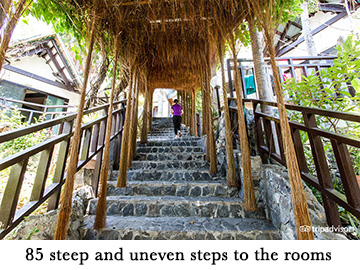 The General Manager of CBR is Southern Californian Mike Bortik, who is not only an outstanding underwater photographer, but also a generous teacher who was happy to help his guests enhance their underwater photo skills. Mike gave some slide shows of his jaw-dropping images and explained the nitty-gritty about how he got the shots, describing such things as camera settings and strobe placement. One of Mike's tips that helped me to get faster at macro focusing was first to learn the minimum focusing distance of your lens (for my 105mm, the minimum is six inches). Mike told me to move my head away from the viewfinder while setting the port about six inches from the subject. Then move back to the viewfinder to focus. Simple and helpful.
The General Manager of CBR is Southern Californian Mike Bortik, who is not only an outstanding underwater photographer, but also a generous teacher who was happy to help his guests enhance their underwater photo skills. Mike gave some slide shows of his jaw-dropping images and explained the nitty-gritty about how he got the shots, describing such things as camera settings and strobe placement. One of Mike's tips that helped me to get faster at macro focusing was first to learn the minimum focusing distance of your lens (for my 105mm, the minimum is six inches). Mike told me to move my head away from the viewfinder while setting the port about six inches from the subject. Then move back to the viewfinder to focus. Simple and helpful. Diver's Compass: A 7-night stay at CBR cost $1,696 per person, double occupancy ($2572 for a single) and included all meals, 18 boat dives, nitrox, and van transportation to and from a Manila hotel (the 78-mile trip is about 2.5-3 hours)
Diver's Compass: A 7-night stay at CBR cost $1,696 per person, double occupancy ($2572 for a single) and included all meals, 18 boat dives, nitrox, and van transportation to and from a Manila hotel (the 78-mile trip is about 2.5-3 hours) 